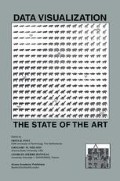Abstract
A way to analyse large time-dependent data sets is by visualization of the evolution of features in these data. The process consists of four steps: feature extraction, feature tracking, event detection, and visualization.
In earlier work, we described the execution of the tracking process by means of basic attributes like position and size, gathered in ellipsoid feature descriptions. Although these basic attributes are accurate and provide good tracking results, they provide little shape information about the features. In other work, we presented a better way to describe the shape of the features by skeleton attributes.
In this paper, we investigate the role that the skeleton graphs can play in feature tracking and event detection. The extra shape information allows detection of certain events much more accurately, and also allows detection of new types of events: changes in the topology of the feature.
Access this chapter
Tax calculation will be finalised at checkout
Purchases are for personal use only
Preview
Unable to display preview. Download preview PDF.
References
Arnaud, Y., Debois, M., and Maizi, J. (1992). Automatic Tracking and Characterization of African Convective Systems on Meteosat Pictures. J. of Appl. Meteorology, 31:443–453.
Ballard, D. and Brown, C. (1982). Computer Vision. Prentice-Hall.
Kalivas, D. and Sawchuk, A. (1991). A Region Matching Motion Estimation Algorithm. CVGIP: Image Understanding, 54(2):275–288.
Messmer, B. and Bunke, H. (1998a). Error-correcting graph isomorphism using decision trees. International Journal of Pattern Recognition and Artificial Intelligence, 12(6):721–742.
Messmer, B. and Bunke, H. (1998b). A new algorithm for error-tolerant subgraph isomorphism detection. IEEE Transactions on Pattern Analysis and Machine Intelligence, 20(5):493–505.
Messmer, B. and Bunke, H. (1999). A decision tree approach to graph and subgraph isomorphism detection. Pattern Recognition, 32(12): 1979–1998.
Reinders, F., Jacobson, M., and Post, F. (2000). Skeleton Graph Generation for Feature Shape Description. In de Leeuw, W. and van Liere, R., editors, Data Visualization 2000, pages 73–82. Springer Verlag.
Reinders, F., Post, F., and Spoelder, H. (1999). Attribute-Based Feature Tracking. In Gröller, E., Löffelmann, H., and Ribarsky, W., editors, Data Visualization ’99, pages 63–72. Springer Verlag.
Reinders, F., Post, F., and Spoelder, H. (2001). Visualization of Time-Dependent Data using Feature Tracking and Event Detection. The Visual Computer, 17(1):55–71.
Reinders, F., Spoelder, H., and Post, F. (1998). Experiments on the Accuracy of Feature Extraction. In Bartz, D., editor, Visualization in Scientific Computing ’98, pages 49–58. Springer Verlag.
Samtaney, R., Silver, D., Zabusky, N., and Cao, J. (1994). Visualizing Features and Tracking Their Evolution. IEEE Computer, 27(7):20–27.
Sethi, I., Patel, N., and Yoo, J. (1994). A General Approach for Token Correspondence. Pattern Recognition, 27(12):1775–1786.
Silver, D. and Wang, X. (1996). Volume Tracking. In Yagel, R. and Nielson, G., editors, Proc. Visualization ’96, pages 157–164. IEEE Computer Society Press.
Silver, D. and Wang, X. (1998). Tracking Scalar Features in Unstructured DataSets. In Ebert, D., Hagen, H., and Rushmeier, H., editors, Proc. Visualization ’98, pages 79–86. IEEE Computer Society Press.
van Walsum, T, Post, F., Silver, D., and Post, F. (1996). Feature Extraction and Iconic Visualization. IEEE Trans, on Visualization and Computer Graphics, 2(2):111–119.
Author information
Authors and Affiliations
Editor information
Editors and Affiliations
Rights and permissions
Copyright information
© 2003 Springer Science+Business Media Dordrecht
About this chapter
Cite this chapter
Vrolijk, B., Reinders, F., Post, F.H. (2003). Feature Tracking with Skeleton Graphs. In: Post, F.H., Nielson, G.M., Bonneau, GP. (eds) Data Visualization. The Springer International Series in Engineering and Computer Science, vol 713. Springer, Boston, MA. https://doi.org/10.1007/978-1-4615-1177-9_3
Download citation
DOI: https://doi.org/10.1007/978-1-4615-1177-9_3
Publisher Name: Springer, Boston, MA
Print ISBN: 978-1-4613-5430-7
Online ISBN: 978-1-4615-1177-9
eBook Packages: Springer Book Archive

